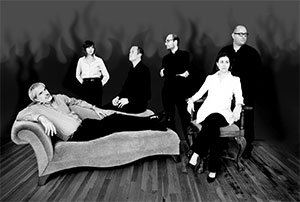by Mike Telin
Currently on
The only non-Jewish composer represented on the program was Maurice Ravel, whose setting of Kaddish, arranged for cello and piano by Nick Diodore, was given a heartfelt performance by Diodore and pianist Nick Underhill to open the program. For some reason it seems as though the area has recently enjoyed a number of recitals of works for solo cello; Diodore continued the program with a vibrant performance of the first and second movements of Ernst Bloch’s Second Suite for Cello.
The music of Morton Feldman is more often then not slow! Very, very slow. “This is a piece of experiential music,” pianist Nick Underhill jokingly told the audience prior a performance of one of Feldman’s more abstract works in which the performer is given motives that can be played in any order. Indeed, Underhill’s performance did sound random as if he could very well have been making it up on the spot. But that was also its beauty. I was having visions of a child being left alone in a room with a piano playing notes softly, but quickly taking their hands off the keyboard so as not to be caught. Underhill also performed Feldman’s Piano Piece (to Philip Guston), an expressive piece perfect for this concert – a concert about an exhibit that features a piece about a piece.
Israeli composer Shualmit Ran’s East Wind for solo flute is an abstract work that utilizes the full range of the instrument, from B below middle C to the D# more than three octaves higher. Full of extended techniques such as flutter and spit tonguing, lip and finger bends as well as key clicks, and written without key signature and bar lines, the work is full of sudden mood and tempo changes. Flutist Sean Gabriel gave East Wind an inspired performance, making easy work of the technical passages as well as adding gentle nuance to the work’s few lyrical moments.
Violist Tom Bowling, a No Exit regular, gave an outstanding performance of Hallucinations by Cleveland State University faculty member Andrew Rindfleisch. Written in memory of violist Walter Trampler, Hallucinations is a four movement work each of which is an etude for the bow-arm. Opening with repetitive, driving and accented drawing of the bow, the second movement is full of fast accented lines. The third, performed with a practice mute, takes musical twists and turns around the minuet of Bach’s G major Cello Suite. The final movement, an elegy, is physically demanding. Marked “senza vibrato” and full of double stops, the movement also required the performer to make continuous use of the full length of the bow. But as we have come to expect, Bowling made even the most demanding sections sound easy, performing with grace and style.
Clarinetist Luke Gorman is a musical and technical force to be reckoned with, and his performance of Corey Rubin’s inventive Party Lines for solo clarinet, was one of the concert’s highlights. Written in the spring of this year, the work’s title looks back to the days when many households shared one telephone line. Party Lines is written in two sections, a prelude and fugue, and performed without pause. Playing with a pure, focused tone, Gorman skillfully brought out the shifting lines of the fugue. To conclude the concert, Rubin reappeared as a vocalist and joined pianist Nick Underhill in a performance of Ravel’s arrangement of Kaddish, a fitting way to close.
Published on ClevelandClassical.com December 18, 2012
Click here for a printable version of this article.



